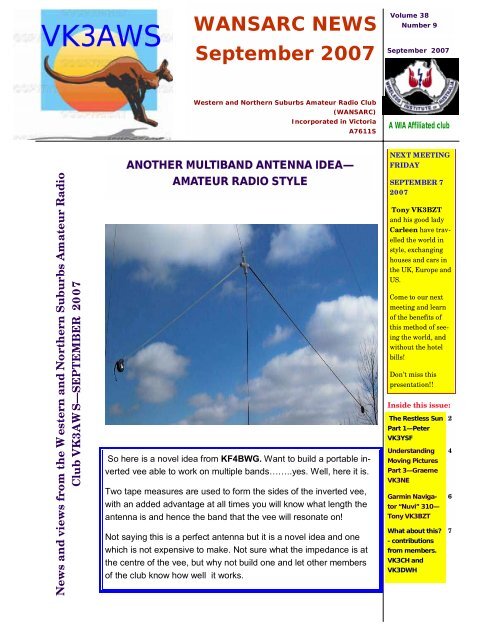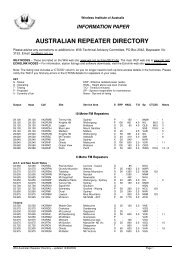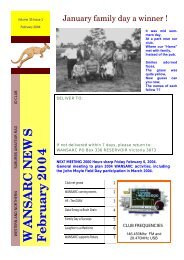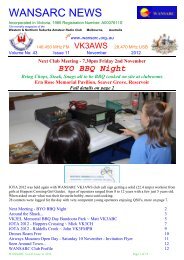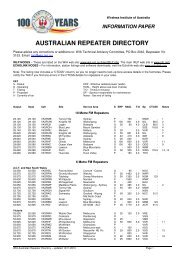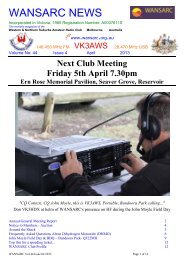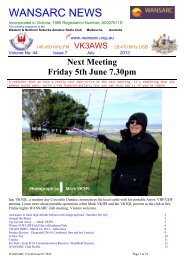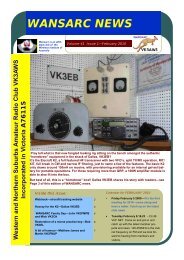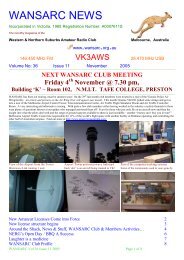WANSARC Vol 38 Issue 09 2007.pdf - Western & Northern Suburbs ...
WANSARC Vol 38 Issue 09 2007.pdf - Western & Northern Suburbs ...
WANSARC Vol 38 Issue 09 2007.pdf - Western & Northern Suburbs ...
You also want an ePaper? Increase the reach of your titles
YUMPU automatically turns print PDFs into web optimized ePapers that Google loves.
VK3AWS<br />
<strong>WANSARC</strong> NEWS<br />
September 2007<br />
<strong>Vol</strong>ume <strong>38</strong><br />
Number 9<br />
September 2007<br />
<strong>Western</strong> and <strong>Northern</strong> <strong>Suburbs</strong> Amateur Radio Club<br />
(<strong>WANSARC</strong>)<br />
Incorporated in Victoria<br />
A7611S<br />
A WIA Affiliated club<br />
News and views from the <strong>Western</strong> and <strong>Northern</strong> <strong>Suburbs</strong> Amateur Radio<br />
Club VK3AWS—SEPTEMBER 2007<br />
ANOTHER MULTIBAND ANTENNA IDEA—<br />
AMATEUR RADIO STYLE<br />
So here is a novel idea from KF4BWG. Want to build a portable inverted<br />
vee able to work on multiple bands……..yes. Well, here it is.<br />
Two tape measures are used to form the sides of the inverted vee,<br />
with an added advantage at all times you will know what length the<br />
antenna is and hence the band that the vee will resonate on!<br />
Not saying this is a perfect antenna but it is a novel idea and one<br />
which is not expensive to make. Not sure what the impedance is at<br />
the centre of the vee, but why not build one and let other members<br />
of the club know how well it works.<br />
NEXT MEETING<br />
FRIDAY<br />
SEPTEMBER 7<br />
2007<br />
Tony VK3BZT<br />
and his good lady<br />
Carleen have travelled<br />
the world in<br />
style, exchanging<br />
houses and cars in<br />
the UK, Europe and<br />
US.<br />
Come to our next<br />
meeting and learn<br />
of the benefits of<br />
this method of seeing<br />
the world, and<br />
without the hotel<br />
bills!<br />
Don’t miss this<br />
presentation!!<br />
Inside this issue:<br />
The Restless Sun 2<br />
Part 1—Peter<br />
VK3YSF<br />
Understanding<br />
Moving Pictures<br />
Part 3—Graeme<br />
VK3NE<br />
Garmin Navigator<br />
“Nuvi” 310—<br />
Tony VK3BZT<br />
What about this<br />
- contributions<br />
from members.<br />
VK3CH and<br />
VK3DWH<br />
4<br />
6<br />
7
Page 2 <strong>WANSARC</strong> NEWS September 2007<br />
The Restless Sun PART 1 Past and Future of the Solar Cycle by Peter VK3YSF<br />
We all find comfort with the cyclical and predictable events in<br />
nature like sunrise, the seasons and for radio hams the solar cycles.<br />
The solar cycle is one of those natural rhythmic cycles that<br />
has reliably peaked every eleven years or so. The cycles may<br />
vary in intensity and have been as short as nine years to as long<br />
sixteen, but they always eventually arrive and that is the truth for<br />
anyone giving them attention.<br />
What are the affects beyond radio propagation and how reliable<br />
are these cycles, what if they stopped or dramatically changed in<br />
their intensity or duration, what would it mean<br />
The solar cycle<br />
The solar cycles are generally thought of as the cyclical rise and<br />
fall in the calculated sunspot number over time. The sunspot<br />
number is calculated by multiplying the number of groups of sunspots<br />
by ten and then adding this product to the total count of<br />
individual spots.<br />
The sunspot number is a way of gauging the level of solar activity or solar radiation which has a direct effect on<br />
the degree of ionization in the upper atmosphere and ultimately determines the degree of path refraction of high<br />
frequency radio waves. Solar radiation, acting on the different compositions of gasses at various heights of the<br />
atmosphere, generates layers of ionization and therefore it follows that the number of sunspots can help predict<br />
conditions on radio HF bands.<br />
The point of highest sunspot activity during this cycle is known as Solar Maximum, and the point of lowest activity<br />
is Solar Minimum.<br />
The sunspots will appear in pairs in a more or less east-west alignment, the eastern sunspot of the pair will be of<br />
one magnetic pole say north and the other western sunspot of the pair will be magnetic south. In the other hemisphere<br />
of the Sun the opposite will be true. This situation will reverse from one solar cycle to the next. Also sunspots<br />
will be near the solar equator towards the end of a given cycle and towards the poles at the beginning of the<br />
next.<br />
The detection of the first opposite magnetic polarity sunspots compared to proceeding cycle’s sunspot polarity<br />
and the observation of high solar latitude sunspots will indicate the beginning of the new cycle, cycle 23 ends cycle<br />
24 begins.<br />
A key indicator that the solar maximum has arrived is that the sun’s magnetic poles flip from north to south that is<br />
the Pole that is magnetic north becomes magnetic south and the Pole that is magnetic south becomes magnetic<br />
north. What this means is that a complete solar cycle, when the Sun’s poles are back to their original magnetic<br />
pole is in fact about 22 years in length.<br />
11,400 years of sunspot history<br />
A really neat piece of research gives a view of what the sun has been doing over more than 11,000 years or as far<br />
back as the last major ice age event.<br />
The Earth is constantly being irradiated by cosmic rays from deep space and these rays produce in the atmosphere<br />
a material known as carbon 14 which is absorbed by trees among other things. Trees even dead trees retain<br />
a record of the levels of carbon 14 being produced over a very long period of time. Charged particles from the<br />
Sun which are greater during periods of high sunspot activity repel the cosmic rays and therefore the more sunspot<br />
activity there is the less carbon 14 is recorded in the tree rings.<br />
Using the carbon 14 level records the sunspot number estimates have been pushed back as far as 11,400 years<br />
into the past and reveal that the current high level of solar activity has not occurred for well over 8,000 years. See<br />
figure 1.
<strong>Vol</strong>ume <strong>38</strong> Number 9<br />
Page 3<br />
Sunspot Number<br />
120<br />
100<br />
80<br />
60<br />
40<br />
20<br />
0<br />
0 2000 4000 6000 8000 10000 12000<br />
Years from present<br />
Figure 1: The data for the 11,400 Year Sunspot Number has been graphed using an Excel<br />
spread sheet. 11,000 Year Sunspot Number data can be found courtesy of the NOAA Paleoclimatology<br />
Program and World Data Center for Paleoclimatology, Boulder.<br />
ftp://ftp.ncdc.noaa.gov/pub/data/paleo/climate_forcing/solar_variability/solanki2004-ssn.txt<br />
More Sunspot Number data: -ROYAL OBSERVATORY OF BELGIUM<br />
http://www.sidc.be/index.php<br />
The solar activity during the last 80 to 100 years is by far the exception. A 2003 study found that<br />
there had been more sunspots since the 1940s than in the previous 1150 years. The fact that<br />
this period of high activity coincided with the invention and development of radio is not lost on<br />
me! Who knows how a world craving communication may have develop if the twentieth century<br />
was one of the dead periods of solar activity.<br />
Subtle changed in their intensity<br />
A period known as the Maunder Minimum from about 1650 to 1715 suddenly saw very few reports<br />
of sunspots. The Maunder Minimum coincided with the coldest part of the period known as<br />
the Little Ice Age. While there appears to be a connection there is generally no agreed mechanism<br />
that would have low sunspot numbers connected with the Earth’s climate in such a dramatic<br />
way. It may have at least been contributing factor, but how much of factor is not clear.<br />
The effect of sunspot activity in relation to climate change is a very controversial issued at the<br />
moment with a complete spectrum of views being voiced. Generally from what I have read and<br />
heard it’s for the most part regarded as minor factor.<br />
Nobody can deny climate change as the only constant when it comes to the Earth’s climate is<br />
change. The relationship between sunspots and the Earth’s climate is far from understood, which<br />
means to me that we can not be certain if sunspot activity has a minor or more significant role on<br />
our climate.<br />
The Dalton Minimum was also period of low solar activity, lasting from about 1790 to 1820. Like<br />
the Maunder Minimum it coincided with a period of lower than average global temperatures.<br />
The cooler temperatures were exasperated by the eruption in 1815 of Mount Tambora on the<br />
island of Sumbawa, in what is now Indonesia. This made the winter of 1816 one of the most miserable<br />
and deadly on recorded. The volcanic eruption clearly made things worse, but the cold<br />
spell was well underway from about 1810.<br />
IN<br />
BRIEF………<br />
President Graeme<br />
VK3NE and Secretary<br />
Mark VK3PI<br />
met with representatives<br />
of Rotary<br />
Reservoir and Darebin<br />
Council to discuss<br />
the potential<br />
for community<br />
groups again utilising<br />
the Ern Rose<br />
Memorial Pavilion.<br />
<strong>WANSARC</strong> was<br />
one of three community<br />
groups who<br />
were forced to leave<br />
these premises<br />
when Darebin<br />
Council decided to<br />
convert the rooms<br />
into a café.<br />
After many years<br />
and a failed tender<br />
process the Ern<br />
Rose Memorial<br />
Pavilion has remained<br />
vacant, certainly<br />
a waste of<br />
valuable community<br />
resource for<br />
such a long time.<br />
The meeting was<br />
very positive.<br />
Council is considering<br />
a request by a<br />
third community<br />
group to utilize the<br />
Pavilion.<br />
Darebin Council<br />
will be in contact<br />
with Graeme or<br />
Mark in the next<br />
two weeks, at<br />
which time the<br />
<strong>WANSARC</strong> committee<br />
will be fully<br />
appraised of Council’s<br />
views on sharing<br />
this community<br />
resource.<br />
Editor comment—congratulations Peter, excellent article. Look forward to Part 2 next month.
Page 4 <strong>WANSARC</strong> NEWS September 2007<br />
UNDERSTANDING “MOVING PICTURES” Part 3 contributed<br />
by Graeme VK3NE<br />
3. Pixel Visibility<br />
In video the visibility of pixels can interfere with your enjoyment of the image. In all cases<br />
XGA with its 64% pixel density advantage will have less visible pixels than the SVGA counterpart.<br />
A 100" image on a VGA projector has 64 pixels per inch, SVGA has 100 and XGA gives<br />
164 pixels/inch. This difference greatly reduces the screen door effect on LCD projectors.<br />
Once again, screen size and viewing distance are relevant factors. Let's replay the demo we<br />
just discussed. At a distance of 10 feet, you won't see any pixel structure On both the pixel<br />
structure is too small for your eye to resolve. But when each projector is blown up to the full<br />
8-foot width of the screen, you will find that the SVGA unit has much more visible pixilation<br />
than does the XGA.<br />
Example: on a modest projection screen of 2 metres width, from an SVGA projector each pixel<br />
is going to be a quarter of a centimetre wide, whereas with an XGA projector the image is going<br />
to be under a fifth of a centimetre wide, and over 60% more pixels are displayed. This<br />
means the image is going to be sharper and less 'blocky' when projecting with an XGA projector.<br />
4. Colour definition<br />
For any given image size XGA machines give you 64% more pixels. That means there is more<br />
capability to define shadings and nuances of colour. For any given image size if you focus on<br />
colour quality alone in a side by side demo, you will see colour tends to look a bit more refined<br />
or elegant on an XGA unit than it does on SVGA.<br />
Conclusion<br />
XGA resolution projectors are usually capable of delivering sharper images with less pixilation<br />
and better colour for any given screen size than their SVGA counterparts. The notion that<br />
since video has only 480 lines, you only need SVGA to display everything in the signal is a<br />
simplistic and erroneous way of thinking about the issue.<br />
SVGA offer a cost advantage over XGA so if price is a major issue consider a used projector<br />
with XGA resolution rather than a new SVGA the difference is huge!.<br />
Resolution and Computers<br />
You should also consider the longer-term investment you are making in a projector. Most<br />
computers sold today run in XGA resolution as standard, and SVGA is used less commonly. If<br />
you start using computers that run using XGA as standard in the future, you may find you are<br />
limited with an SVGA projector.<br />
Can't I just change my resolution setting and buy an SVGA projector<br />
Yes you can, but the payoff is that you will lose sharpness and will have the inconvenience of<br />
having to make sure your computer is always in SVGA mode for presentations.<br />
What is compression<br />
Most projectors will accept a resolution higher than their native resolution, but will compress<br />
the computer's image into fewer pixels. The result is that some of the computer's pixels are<br />
shared across the same pixel that the projector displays. This is less important with photos<br />
and video, because you don't notice it so much, but with text it's a different story especially<br />
small text, as illustrated by the picture below.
<strong>Vol</strong>ume <strong>38</strong> Number 9<br />
Page 5<br />
The projector will automatically convert the incoming 1,024 x 768 signal to its native 800 x<br />
600 output. However, there is always a loss of sharpness and detail in the process, so you will<br />
end up with a picture that is not quite as sharp as if the incoming signal had been the same<br />
format as the projector's native resolution.<br />
This loss of sharpness also happens if you plug an SVGA computer into a higher-resolution<br />
XGA projector. You will usually<br />
get a decent image, but the<br />
conversion from the 800 x 600<br />
input to a 1,024 x 768 output<br />
will produce some fuzziness<br />
that you may not appreciate<br />
after having spent the money<br />
for an XGA projector.<br />
FROM THE WIA………………….Dates Set For Spring VHF-UHF Field Day 2007.<br />
The Spring VHF-UHF Field Day for 2007 will be held over the weekend of November 17 and<br />
18. This is a week later than in past years. The change of dates avoids clashes with some club<br />
activities that will taking place earlier in the month.<br />
There are two minor changes in the rules:<br />
Native (True) Resolution<br />
Computer and projector matched.<br />
(Simulated Image, Enlarged 300%)<br />
1. Stations may enter both the 24 hour and 8 hour sections, but only if the station actually<br />
operates for more than 8 hours.<br />
2. Changing locations: It is not in the spirit of the contest for grid-hoppers to set up more<br />
than one station and move between them. The rules now make it clear that not only the<br />
operator but also the station must be moved when operating locations are changed.<br />
Please note also the rule on the use of DX calling frequencies. Where possible, contest activity<br />
should focus on the recommended contest calling frequency.<br />
Dates<br />
Saturday and Sunday November 17 and 18, 2007.<br />
Duration in all call areas other than VK6: 0100 UTC Saturday to 0100 UTC Sunday.<br />
Duration in VK6 only: 0400 UTC Saturday to 0400 UTC Sunday.<br />
Full rules can be obtained from www.wia.org.au<br />
Non-Native Resolution<br />
Computer is at a higher resolution<br />
than the projector (compression).<br />
(Simulated Image, Enlarged 300%)<br />
QSL CARDS<br />
WANTED………<br />
In 20<strong>09</strong> WAN-<br />
SARC will celebrate<br />
its 40th<br />
birthday and<br />
your Secretary<br />
Mark VK3PI is<br />
collating information<br />
to produce a<br />
history of WAN-<br />
SARC.<br />
This history will<br />
focus on the<br />
people who have<br />
made WAN-<br />
SARC what it is.<br />
To assist in compiling<br />
this history<br />
2 blank QSL<br />
cards would be<br />
appreciated (one<br />
spare in just in<br />
case).<br />
So if you have a<br />
QSL card,<br />
please provide a<br />
couple to Mark<br />
VK3PI.<br />
Similarly if you<br />
have any photo’s<br />
from <strong>WANSARC</strong><br />
of old, we would<br />
love to see them<br />
and scan<br />
these for the<br />
history.<br />
Sense of humour at the Hong Kong Ship naming<br />
department (left) and (right) “Did you say we may<br />
have some shallow water ahead”
<strong>Vol</strong>ume <strong>38</strong> Number 9<br />
. GARMIN NAVIGATOR NUVI 310<br />
by Tony Saunders VK3BZT<br />
One of the most useful devices I have used for car navigation is the GPS navigator.<br />
I purchased a unit from Harvey Norman, a navigator I call ‘Nuvi’ and use it<br />
everywhere, especially useful for overseas driving.<br />
I had to buy European maps software on a DVD disc, load it into my computer,<br />
and then download the areas I wanted (Germany, France and England) on to the<br />
navigator. Although the software is expensive, $550.00 Australian at the Garmin<br />
shop in St Kilda, it is worth every cent. My SD card in the navigator holds nearly<br />
2 gigabytes of data for every street in the whole of Germany, France and U.K. A<br />
lot of data that will give clear oral and visual driving guidance.<br />
Germans drive like crazy on the<br />
outer lane of their autobahns.<br />
The photo at left shows how I<br />
strapped ‘Nuvi’ with a rubber<br />
band around the antenna to a<br />
teddy bear stuck on the dash<br />
board by the car owner. Nuvi was<br />
able to accurately navigate me<br />
down this small street in a small<br />
town in Germany with minute detail<br />
and then back to my home a<br />
hundred kilometres away.<br />
It didn’t take me long to join<br />
them. I had to see legally what<br />
the 12 year old Mercedes Benz<br />
would do flat to the floor. The<br />
speedo needle reached 200 kph<br />
but the navigator showed the car<br />
speedo read 6kph high (right) and true speed was only 194kph (120mph). That<br />
was fast enough for me, I pulled over and two following cars raced past well over<br />
200kph. Most sit on about 130kph and trucks are limited to 80kph but usually do<br />
about 90 to 95kph. I respect truck drivers more than I do car drivers—car drivers<br />
have little respect for speed restrictions. Poms, who only occasionally indicate<br />
change of direction, are even worse. Don’t let anyone tell you European<br />
drivers are better than Australians, they are not.<br />
Page 6<br />
J.O.T.A<br />
October<br />
2007<br />
Jamboree of the Air<br />
(JOTA) is run each<br />
year to support the<br />
Scout, Girl Guide and<br />
Venturer movements<br />
in their endeavours<br />
to attain communication<br />
badges, contact<br />
other groups and generally<br />
have a great<br />
activities weekend.<br />
Club member and<br />
Scout leader Ian<br />
VK3JQ is again seeking<br />
assistance from<br />
club members for the<br />
GOLDEN JUBILEE<br />
JOTA on Saturday<br />
October 21 and Sunday<br />
October 22, 2007.<br />
If you have some time to<br />
spare and would like to<br />
contribute to spreading<br />
the “amateur radio<br />
word”, contact Ian<br />
VK3JQ via email at:<br />
vk3jq@yahoo.com.au<br />
*****Footnote—Tony and Carleen have had many wonderful adventures swapping<br />
houses and cars in the UK, Europe and the United States. Come and hear of these<br />
adventures at our next club meeting FRIDAY SEPTEMBER 7, 2007. 1930 hours sharp.
Page 7 <strong>WANSARC</strong> NEWS September 2007<br />
WHAT ABOUT THIS Contributions from members<br />
GET<br />
WELL<br />
SOON<br />
Graham<br />
VK3FTTG has<br />
recently suffered<br />
and injury<br />
which precludes<br />
driving at night.<br />
Get well soon<br />
Graham and<br />
look forward to<br />
seeing you back<br />
at the club<br />
meetings.<br />
Many members<br />
have had a bout<br />
of the flu, or<br />
similar strains.<br />
Good to hear<br />
most have<br />
shaken it off!<br />
EMDRC CELEBRATES 40 YEARS<br />
On Sunday 26 August, I was listening to the weekly EMDRC broadcast and discovered<br />
EMDRC was holding a 40 th anniversary dinner, celebrating 40 years of EMDRC<br />
as a formal club.<br />
A quick look at their website and an invite was found, but with an RSVP of 2 weeks<br />
prior! A phone call later I found that 1 seat was spare, so I said “I’ll take it!”.<br />
One shower and 30 minute drive later I arrived 7 minutes before the formal luncheon<br />
was about to start. An excellent 3 course meal held at the Knox Club, with many tables<br />
full of some new, but many familiar faces. I also got to meet up with the voice<br />
behind the weekly Net, Carl VK3EMF.<br />
A big 40 th birthday cake was sung to, with<br />
candles being extinguished by EMDRC club<br />
president Bryan VK3HXR (right). The quote<br />
of the day must go to Bryan VK3HXR, who<br />
said, “… after getting my license I was looking<br />
for a club to join and found the EMDRC. I<br />
was telling a friend who told me, and to my<br />
regret foolishly believed him when he said, ‘..<br />
Oh don’t bother joining the EMDRC, they are<br />
quite a clicky club…’ about a year later I did<br />
join and I have bee made welcome ever since…” Well Bryan, I can echo your sentiments,<br />
I am yet to find ANY Melbourne club that would make any ham feel unwelcome,<br />
a great additional benefit of the hobby, one that should be pushed and advertised<br />
much more, be it EMDRC, NERG, <strong>WANSARC</strong> or any other club.<br />
Congratulations EMDRC on 40 years from all of us at <strong>WANSARC</strong>.<br />
Microphone information<br />
We have all been there—searching for the circuit diagram for our favourite<br />
rig or our microphone test jig.<br />
From Mick<br />
VK3CH<br />
From Dan<br />
VK3DWH<br />
No more—here is a link to a website which has a plethora of information<br />
on microphones and connectors:<br />
http://homepage.ntlworld.com/rg4wpw/date.html<br />
Here is a typical example of information from this site.<br />
KENWOOD-T599S-TS120S-120V-700G-700S-130S-130V-490-520S-530S-820S-<br />
830S-TR2300-TR2200-TR2200GX-TR3200-TR7010-TR7200-TR7200G-TR7400A-<br />
TR7500-TR7600-TR7625<br />
Your magazine<br />
contributors this<br />
month include—<br />
Tony VK3BZT,<br />
Graeme VK3NE,<br />
Peter VK3YSF,<br />
Mick VK3CH,<br />
Dan VK3DWH,<br />
Ian VK3JQ<br />
Thanks folks!<br />
PIN2<br />
PIN3<br />
PIN4<br />
PIN1 MIC<br />
PTT<br />
PTT/EARTH<br />
SCREEN AND EARTH
<strong>WANSARC</strong> VK3AWS<br />
PRESIDENT:<br />
Graeme McDiarmid VK3NE vk3ne@wia.org.au<br />
SECRETARY: Mark Stephenson VK3PI Telephone: 0400 443 218<br />
vk3pi@optusnet.com.au<br />
All correspondence to be addressed to the SECRETARY: PO Box 336<br />
<strong>WANSARC</strong> is at<br />
www.wansarc.org.au<br />
0r www.wansarc.org<br />
C LUB<br />
FACES<br />
RESERVOIR 3073<br />
<strong>WANSARC</strong> CLUB PROFILE<br />
History<br />
The <strong>Western</strong> and <strong>Northern</strong> <strong>Suburbs</strong> Amateur Radio Club (<strong>WANSARC</strong>) was first formed in 1969<br />
and since then has served the needs and interests of amateur radio operators, short wave listeners<br />
and those interested in hobby radio and electronics. The club is not gender specific, having<br />
both female and male members. Members come from all walks of life with a mix of experience,<br />
young and mature, novice and technical. The most important aspect of the club is the willingness<br />
of all members to share their knowledge for the benefit of others. Members mainly reside in<br />
the west and north of Melbourne; however membership is encouraged from all interested.<br />
Meetings<br />
Building K, <strong>Northern</strong> Metropolitan Institute of Technology (NMIT), St. Georges Road, Preston<br />
(<strong>Western</strong> side between Bell Street and Cramer Street) Melway 18 E12 PARKING at NMIT-<br />
Members please note that parking adjacent to the club room building K is illegal and NMIT staff<br />
WILL book any cars which are parked in that area. ALL members must park cars in the main car<br />
park to the WEST of building K. Just look for vehicles with lots of aerials! Meetings held on the<br />
1st Friday of each month (excluding January) commencing at 7.30pm local time.<br />
Talk in on 146.450MHz FM—call club station VK3AWS.<br />
Benefits<br />
Who is this This is the club<br />
mascot…...one of the most recognisable<br />
symbols of Australia<br />
utilized by <strong>WANSARC</strong> since<br />
1969. Represents the spirit of<br />
<strong>WANSARC</strong>—the humble KAN-<br />
GAROO.<br />
Free technology and related presentations, sponsored construction activities, discounted (and<br />
sometimes free) equipment, network of like minded radio and electronics enthusiasts, excellent<br />
club facilities and environment plus an informative monthly newsletter for members to post articles,<br />
news, classifieds for all radio, test equipment, etc, featuring Amateur Radio news from<br />
<strong>WANSARC</strong>, WIA, ACMA, Melbourne Clubs, VK and Worldwide.<br />
Club Nets<br />
146.450MHz FM each Tuesday evening commencing 7.30pm local time. Also monitor<br />
28.470MHz on 10 metres USB.<br />
More Information: Website: www.wansarc.org.au Email: wansarc@wia.org.au<br />
Postal: <strong>WANSARC</strong> PO Box 336 RESERVOIR 3073<br />
NEXT MEETING FRIDAY SEPTEMBER 7, 2007<br />
For sale<br />
Tony VK3BZT on overseas holidays<br />
where you swap your house and car.<br />
Australia Post<br />
stamp here<br />
This month browse<br />
through the “ODDS AND<br />
SODS” box of bits and<br />
pieces. You too could take<br />
home a treasure for the<br />
cost of a gold coin donation—all<br />
proceeds to the<br />
club<br />
If not delivered within 7 days please return to<br />
<strong>WANSARC</strong> PO Box 336 Reservoir 3073


